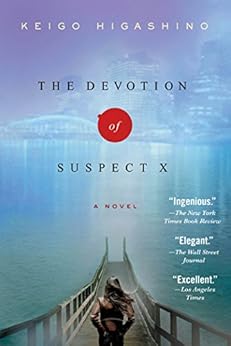One of the
authors mentioned, Keigo Higashino, I’ve recently read. Here’s my review of Keigo Higashino’s Under the Midnight Sun, one of his
standalone novels: http://schatjesshelves.blogspot.ca/2017/01/review-of-under-midnight-sun-by-keigo.html.
***************
Higashino has
also written several books in the Detective Galileo series. The first book is The Devotion of Suspect X.
Review of The Devotion of Suspect X
3
Stars
Tetsuya
Ishagami, a math genius, helps a woman, Yasuko Hanmaoka, hide the murder of her
ex-husband. Motivated by his infatuation for Yasuko, Ishagami disposes of the
body and constructs an alibi for both Yasuko and her daughter.
Kusanagi,
the lead detective, tells his friend, Manabu Yukawa, a university physics
professor, about the case. What results is an intellectual battle between two
geniuses, one intent on constructing the perfect crime and the other on using
logic to solve it.
The ending
is an unguessable twist because the author withheld information from the
reader. Even after everything is explained, the conclusion is unsatisfactory:
the extent of Ishagami's devotion seems unbelievable, and Yukawa's behaviour,
especially considering his friendship with Ishagami, is hurtful.
The pace is
quick and the book is very readable, but one cannot help but feel cheated in
the end.
***************
There is
also a second Higashino series, this one featuring Detective Kaga. The first novel in this series to be translated into English is entitled Malice.
Review of Malice
4
Stars
This
Japanese mystery is a must-read.
Osamu
Nonoguchi, a children’s author, discovers the body of Kunihiko Hidaka, a
childhood friend and fellow author. Detective Kyochiro Kaga investigates and
soon comes to suspect Nonoguchi though he seems to have a perfect alibi. The
difficulty is identifying a motive. Kaga begins digging into the past and
uncovers startling information about the two men’s school days and their
literary careers. But theory after theory about the motive proves to be
incorrect. Will the case ever be satisfactorily solved?
As a
whodunit, the story is a locked room mystery which is solved rather quickly. It
is when the book becomes a whydunit that it excels. The book could really be
identified as a study of the psychology of murder. And what it reveals is
chilling.
This struck
me as very much a Sherlock Holmes mystery. There is little reliance on
forensics. It is the determination and intelligence of the detective that solve
the case. The novel is narrated through a series of journal entries kept by
Kaga and Nonoguchi so the reader is given all the information Kaga has at his
disposal. The reader is expected to be observant and try to make sense of the
clues. (Hint: if something doesn’t seem quite right, it probably isn’t.) So
many mysteries cheat by keeping information from readers; this was a problem
with the other Higashino novels I’ve read (The
Devotion of Suspect X and Salvation
of a Saint). In Malice, however,
there is no such ploy so the book really challenges the reader.
Because we
learn so much background about Nonoguchi, Kaga and even Hidaka, they emerge as
characters with depth, not the flat characters often encountered in second-rate
mysteries. Kaga certainly earns the reader’s admiration and respect, and both
the victim and his murderer will garner some sympathy.
This book
appeared on the 2015 summer mystery reading list compiled by a panel on Shelagh
Roger’s The Next Chapter on CBC
Radio. I am certainly happy that it made it to my reading list.
***************
Another
Japanese crime writer I would recommend is Six
Four by Hideo Yokoyama which I read earlier this month: http://schatjesshelves.blogspot.ca/2017/03/review-of-six-four-by-hideo-yokoyama.html.


No comments:
Post a Comment